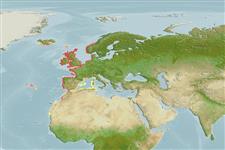Common names from other countries
>
Blenniiformes (Blennies) >
Blenniidae (Combtooth blennies) > Salariinae
Etymology: Lipophrys: Greek, lipos = fat + Greek, ophrys = eyebrow (Ref. 45335).
More on author: Linnaeus.
Environment: milieu / climate zone / depth range / distribution range
Ecología
marino demersal; no migratorio; rango de profundidad 0 - 8 m (Ref. 5981). Temperate; 65°N - 18°N, 32°W - 11°E
Eastern Atlantic: southern Norway to Morocco and Madeira, including the Mediterranean and the Balearics.
Length at first maturity / Tamaño / Peso / Age
Maturity: Lm 8.0 range ? - ? cm
Max length : 17.0 cm TL macho / no sexado; (Ref. 747); edad máxima reportada: 10 años (Ref. 35388)
Espinas dorsales (total) : 12; Radios blandos dorsales (total) : 18; Espinas anales: 2; Radios blandos anales: 18 - 19. Skin naked and slimy. No tentacles on the head. Dip in the middle of dorsal fin. Variable coloration (Ref. 35388).
Facultative air-breathing (Ref. 126274); A resident intertidal species with homing behavior (Ref. 32612) found in shallow waters of rocky coasts. May remain out of water under rocks or seaweeds (Ref. 31184). Mostly active at daytime during high tide. Breathes air when out of water (Ref. 31184). Feeds on small benthic invertebrates, especially gastropods, barnacles and amphipods, and algae (Ref. 31184). Also, diet of crabs, polychaetes, isopods, copepods, limpets, mussels and small molluscs (Ref. 94105). Oviparous (Ref. 205). Eggs measuring 1.5 mm (Ref. 35388) are demersal and adhesive (Ref. 205). Spawning takes place in April - August (Ref. 35388).
Oviparous, distinct pairing (Ref. 205). Male guards eggs from several females (Ref. 5981).
Zander, C.D., 1986. Blenniidae. p. 1096-1112. In P.J.P. Whitehead, M.-L. Bauchot, J.-C. Hureau, J. Nielsen and E. Tortonese (eds.) Fishes of the North-eastern Atlantic and the Mediterranean, volume 3. UNESCO, Paris. (Ref. 5981)
IUCN Red List Status (Ref. 130435)
CITES (Ref. 128078)
Not Evaluated
Threat to humans
Harmless
Human uses
Pesquerías: sin interés; Acuario: Acuarios públicos
Herramientas
Special reports
Download XML
Fuentes de Internet
Estimates based on models
Preferred temperature (Ref.
115969): 9.8 - 19.3, mean 12.3 (based on 364 cells).
Phylogenetic diversity index (Ref.
82804): PD
50 = 0.7500 [Uniqueness, from 0.5 = low to 2.0 = high].
Bayesian length-weight: a=0.01072 (0.00480 - 0.02393), b=3.01 (2.82 - 3.20), in cm Total Length, based on LWR estimates for this (Sub)family-body shape (Ref.
93245).
Nivel trófico (Ref.
69278): 3.5 ±0.33 se; based on food items.
Resiliencia (Ref.
120179): Medio, población duplicada en un tiempo mínimo de 1.4-4.4 años (tmax=10; k=0.3).
Fishing Vulnerability (Ref.
59153): Low to moderate vulnerability (33 of 100).
